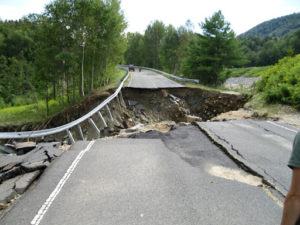An important aspect of conservation of water, soil, and habitat that is often overlooked are drainage control structures. If they work right, then they usually become essentially invisible. When they don’t, incredible damage can result.
Floods or high flow events will always be with us. But it’s our water control measures or drainage structures, that if properly designed, can mean the difference between just another beautiful day and disaster, with its accompanying potential loss of life. The above is an extreme example, but not so much as you might think. In Cornish, high rain storms and snowmelt runoff this spring caused a few road closures and extensive repairs to put things right.
Culverts are not only designed to pass water flow under roads and driveways, but can provide a critical conveyance for wildlife habitat and fish passage. They need to be designed to minimize impacts to the natural channel wherever possible. Type, size strength requirements, location, pipe material and environmental issues are all important elements of culvert design. It’s certainly an engineering task to balance the many needs we place on these structures. In addition to the initial design and installation, maintenance is needed to keep them functional. Given their importance, permits are required before installation to provide for proper review and evaluation.
In addition to culverts, ponds and dams also serve as important water control measures. In many instances, dams are used to create a pond or impoundment. Depending on the height of a dam or size of a pond, it would fall under jurisdiction of the State of NH and would require periodic inspections. The pond acts as a buffer to control water by delaying the time for water to pass and can act as an energy dissipator to reduce potential destructive energy in fast moving water flow. Many ponds and dams have a concrete outfall that directs the flow to the natural channel.
Effective use of culverts and other water control measures requires a technical understanding of hydraulic and fluid analysis as well soil mechanics to control erosion and sediment along with the management of water quality and pollutant loading. Given the importance of drainage as it applies to roads and bridges, The NH Bureau of Bridge Design and Bureau of Highway Design share the responsibility for design of drainage. The separation of responsibility is based upon the size of the structure involved.
The photo below was taken on a road during Hurricane Irene in 2011 that just a few minutes before had been structurally sound. A culvert became clogged and water ran over the road and undermined the entire road. The repairs and material required to open this road were extensive and the road was closed for more than a month. A great example of the power of water. Which underscores the importance of keeping water flowing where it belongs.
Currently, there is no official count in Cornish of all the installed culverts. It’s safe to say that the number of culverts in Cornish measure at least in the hundreds and maybe as high as 1500. On the dam side, according to the NH Dam Bureau, there are around 38 dams in Cornish. Most are impoundments for individual ponds, or fire ponds. Some of the more important dams in town include the Blow-Me Down Mill Pond near St Gaudens, the swimming hole on Leavitt Hill Road, and the Whitewater Reservoir.

